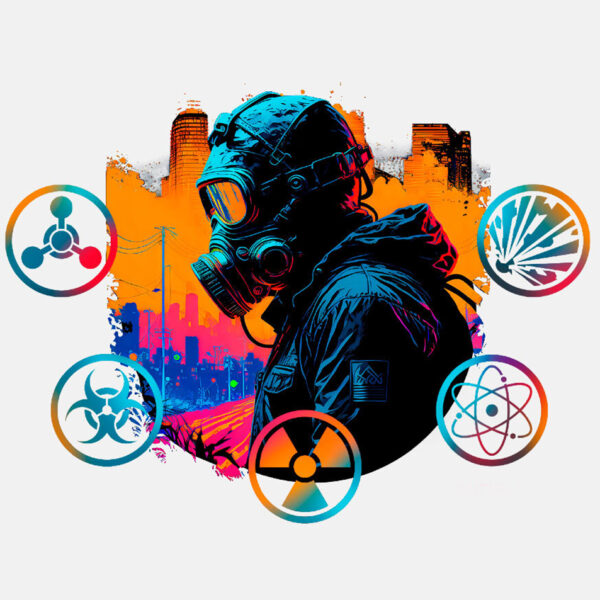Medical Management and Prehospital Considerations – Cohort 1
Delve into the medical aspects of CBRNE-WMD incidents, from triage and patient management to medical countermeasures and decontamination procedures. This credential emphasizes the roles of pre-hospital and hospital responders in managing CBRNE casualties.
ABOUT THIS COURSE
This comprehensive course provides medical professionals and emergency responders with the knowledge and skills necessary for effective response to CBRNE-WMD (Chemical, Biological, Radiological, Nuclear, and Explosive–Weapons of Mass Destruction) incidents. It begins with an overview of threat classifications, mass casualty dynamics, and the critical roles of both pre-hospital and hospital-based interventions. Subsequent modules focus on clinical assessment, diagnosis, and treatment of injuries and illnesses caused by high-yield explosives, radiological and nuclear exposures, chemical agents, and biological threats, emphasizing PPE usage, decontamination procedures, and responder safety. The course also introduces triage systems such as SALT and START and concludes by connecting learners with key federal, state, and local preparedness resources, including the Strategic National Stockpile, Chempack, Medical Reserve Corps, and intelligence coordination centers to enhance integrated CBRNE medical response.
Overview
Modality
online
Format
Pricing
$249.00
Partner
RevU
Topic
COURSE REQUIREMENTS
To be eligible for the GW RevU Micro-Credential Program, applicants must meet the following minimum requirements:
- Academic and Professional Standing: Applicants must be in good professional standing and have been actively working in their field of study or service for at least two years.
- Professional Background: Candidates with relevant experience in fields such as healthcare, public health, emergency management, law enforcement, security, engineering, environmental sciences, elected officials, telecommunications, or any other discipline associated with private sector or governmental roles in CBRNE (Chemical, Biological, Radiological, Nuclear, and Explosive) threat detection, mitigation, or consequence management are eligible for consideration.
- Submission of Documents: Each applicant is required to submit a current resume outlining their professional experience. Additionally, a letter of endorsement from a supervisor or someone in their chain of command is mandatory to verify their qualifications and support their participation in the program.
COURSE SYLLABUS
Module 1: Introduction to CBRNE-WMD Medical Response
- Classifications of CBRNE threats
- Characteristics of CBRNE-WMD mass casualty incidents
- Roles of pre-hospital and hospital intervention in saving lives in CBRNE-WMD incidents
- PPE and contamination issues
- Responder / Receiver safety in CBRNE attacks
- Secondary devices on-scene and at nearby HCFs
Module 2: High-yield Explosive Incidents
- Patient assessment (blast injuries) and Hx
- S/Sx
- Triage and prioritization
- Dx
- Tx
Module 3: Radiological Agents & Nuclear Incidents
- Material and radiation types/exposures, post-blast characteristics
- Agent type, characteristics, and pathophysiology
- PPE considerations
- Contamination transfer and exposure pathway considerations
- Patient decon considerations in the field at at HCFs
- Decontamination wasted disposal at HCF
- Patient assessment and Hx; S/Sx; Triage and Prioritization; Dx, MCM and Tx
- Specific preparedness and response resources for pre-hospital and medical personnel
Module 4: Chemical Agents
- Agent type, characteristics, and pathophysiology
- PPE considerations
- Contamination transfer and exposure pathway considerations
- Patient decon considerations in the field at at HCFs
- Decontamination wasted disposal at HCF
- Patient assessment and Hx; S/Sx; Triage and Prioritization; Dx, MCM and Tx
- Specific preparedness and response resources for pre-hospital and medical personnel
Module 5-6: Biological Agents, Part I and II
- Replicating agent type, characteristics, and pathophysiology
- PPE considerations
- Contamination transfer/fomites, reaerosolization potential, and communicability considerations
- Patient decon and infection prevention considerations in the field at at HCFs
- Patient assessment and Hx; S/Sx; Triage and Prioritization; Dx, MCM and Tx
- Crim-epi considerations and local contacts
- Specific preparedness and response resources for pre-hospital and medical personnel
Module 7: Introduction to SALT Mass Casualty Triage Algorithm & START System
Module 8: Engaging and Leveraging Accessible Resources, Programs, and Organizations
- Public Health / Public Health Emergency Preparedness (PHEP)
- National Disaster Medical System
- Hospital Preparedness Program
- Strategic National Stockpile and local MCM caches
- Chempack
- Medical Reserve Corps
- Disaster Behavioral Health
- Intelligence Fusion Centers (medical liaisons)
- FBI field offices (WMD coordinators)
- DHS Office of Health Security Regional Medical Offices
- ASPR Regional Emergency Coordinators
- Current CBRNE programs and resources for first responders and receivers
RELATED COURSES
Come Explore What GW RevU Can Offer You























